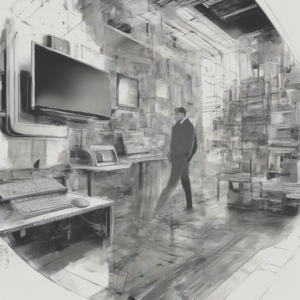Revolutionizing Industries: A Deep Dive into Industrial Automation Systems
Industrial automation systems are transforming manufacturing, production, and various other industries by automating tasks, optimizing processes, and enhancing efficiency. This comprehensive exploration delves into the intricacies of these systems, covering their components, types, benefits, challenges, and future trends.
Components of Industrial Automation Systems
A typical industrial automation system comprises several interconnected components, working in harmony to achieve desired automation goals. These components include:
- Programmable Logic Controllers (PLCs): The brain of the operation, PLCs are robust computers designed for industrial environments, controlling and monitoring various processes based on pre-programmed instructions.
- Human-Machine Interfaces (HMIs): These interfaces serve as the communication bridge between human operators and the automation system, allowing for monitoring, control, and troubleshooting.
- Sensors and Actuators: Sensors gather real-time data about the production process, such as temperature, pressure, and flow rate. Actuators, on the other hand, respond to these inputs by controlling equipment like valves, motors, and robotic arms.
- Industrial Robots: Robots perform repetitive, precise tasks with high speed and accuracy, significantly improving productivity and reducing human error.
- Supervisory Control and Data Acquisition (SCADA) Systems: SCADA systems provide a centralized platform for monitoring and controlling multiple automation systems across a large facility or even geographically dispersed locations.
- Industrial Networks: Reliable and secure communication networks are crucial for connecting all the components of an industrial automation system, enabling seamless data exchange and control.
- Data Acquisition and Analysis Tools: These tools collect, process, and analyze vast amounts of data generated by the automation system, providing valuable insights for optimization and decision-making.
- Safety Systems: Ensuring the safety of personnel and equipment is paramount. Safety systems incorporate emergency stop mechanisms, interlocks, and other features to prevent accidents.
Types of Industrial Automation Systems
Industrial automation systems are broadly classified into various types, each tailored to specific applications and needs:
- Fixed Automation: This approach involves dedicated machinery designed for a specific task, often seen in high-volume production lines with little variation.
- Programmable Automation: This allows for greater flexibility, as the system can be reprogrammed to perform different tasks, adapting to changing production needs.
- Flexible Automation: This offers the highest degree of flexibility, enabling the system to handle a wide range of products and variations with minimal reconfiguration.
- Computer Integrated Manufacturing (CIM): CIM integrates various aspects of manufacturing, such as design, planning, production, and quality control, through computer systems, creating a fully integrated and automated environment.
Benefits of Implementing Industrial Automation Systems
Implementing industrial automation systems offers a multitude of advantages across various sectors:
- Increased Productivity and Efficiency: Automation streamlines processes, eliminates manual labor for repetitive tasks, and increases overall output.
- Improved Product Quality and Consistency: Automated systems maintain consistent standards, reducing errors and improving the quality of finished products.
- Reduced Costs: Automation minimizes labor costs, material waste, and production time, leading to significant cost savings.
- Enhanced Safety: Automation reduces the risk of workplace injuries associated with hazardous or repetitive tasks.
- Improved Data Collection and Analysis: Automated systems generate large amounts of data that can be analyzed to optimize processes and identify areas for improvement.
- Increased Flexibility and Adaptability: Many automation systems are adaptable to changing demands, allowing businesses to respond quickly to market shifts.
- Better Inventory Management: Real-time monitoring and tracking of inventory levels improve efficiency and reduce storage costs.
- Enhanced Traceability: Automated systems often track each product’s journey, ensuring traceability for quality control and recall purposes.
Challenges in Implementing Industrial Automation Systems
Despite the numerous benefits, implementing industrial automation systems presents certain challenges:
- High Initial Investment Costs: Purchasing and installing automation equipment can be expensive, requiring significant upfront investment.
- Integration Complexity: Integrating various components of the automation system can be complex, requiring specialized expertise.
- Maintenance and Upkeep: Industrial automation systems require regular maintenance and upkeep to ensure optimal performance.
- Cybersecurity Risks: Connected automation systems are vulnerable to cyberattacks, requiring robust cybersecurity measures.
- Skill Gaps: Implementing and managing automation systems requires a skilled workforce, and there may be a shortage of qualified personnel.
- Resistance to Change: Employees may resist the implementation of automation due to fear of job displacement or changes in work routines.
- Legacy System Integration: Integrating new automation systems with older, legacy systems can be challenging and require significant effort.
Future Trends in Industrial Automation Systems
The field of industrial automation is constantly evolving, with several key trends shaping its future:
- Artificial Intelligence (AI) and Machine Learning (ML): AI and ML are enhancing automation systems with capabilities such as predictive maintenance, process optimization, and autonomous decision-making.
- Internet of Things (IoT): IoT enables the connection of a wide range of devices and systems, creating a more interconnected and intelligent industrial environment.
- Cloud Computing: Cloud-based platforms offer scalability, flexibility, and cost-effectiveness for managing and analyzing data from industrial automation systems.
- Robotics and Automation: Advances in robotics are leading to more sophisticated and versatile robots capable of performing complex tasks.
- Digital Twins: Digital twins create virtual representations of physical assets and processes, allowing for simulation, optimization, and predictive maintenance.
- Edge Computing: Processing data closer to the source (the edge) reduces latency and improves real-time responsiveness in automation systems.
- Augmented Reality (AR) and Virtual Reality (VR): AR and VR are enhancing training, maintenance, and troubleshooting processes in industrial settings.
- Industry 4.0 and Smart Factories: Industry 4.0 represents the convergence of various technologies, creating smart factories that are highly automated, interconnected, and data-driven.
Industrial automation systems are playing an increasingly critical role in shaping the future of manufacturing and various other industries. While challenges exist, the benefits of increased efficiency, productivity, and safety make the investment in these systems compelling for organizations seeking to maintain a competitive edge in today’s dynamic global marketplace.




